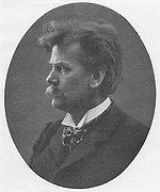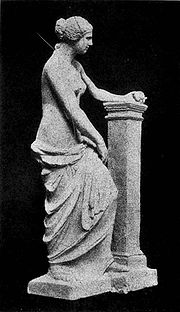
Adolf Furtwängler
Encyclopedia
Adolf Furtwängler was a famous German
Germany
Germany , officially the Federal Republic of Germany , is a federal parliamentary republic in Europe. The country consists of 16 states while the capital and largest city is Berlin. Germany covers an area of 357,021 km2 and has a largely temperate seasonal climate...
archaeologist, teacher, art historian and museum director. He was the father of the conductor Wilhelm Furtwängler
Wilhelm Furtwängler
Wilhelm Furtwängler was a German conductor and composer. He is widely considered to have been one of the greatest symphonic and operatic conductors of the 20th century. By the 1930s he had built a reputation as one of the leading conductors in Europe, and he was the leading conductor who remained...
and grandfather of the German
Germany
Germany , officially the Federal Republic of Germany , is a federal parliamentary republic in Europe. The country consists of 16 states while the capital and largest city is Berlin. Germany covers an area of 357,021 km2 and has a largely temperate seasonal climate...
archaeologist Andreas Furtwängler.

Leipzig
Leipzig Leipzig has always been a trade city, situated during the time of the Holy Roman Empire at the intersection of the Via Regia and Via Imperii, two important trade routes. At one time, Leipzig was one of the major European centres of learning and culture in fields such as music and publishing...
and at Munich
Munich
Munich The city's motto is "" . Before 2006, it was "Weltstadt mit Herz" . Its native name, , is derived from the Old High German Munichen, meaning "by the monks' place". The city's name derives from the monks of the Benedictine order who founded the city; hence the monk depicted on the city's coat...
, where he was a pupil of Heinrich Brunn
Heinrich Brunn
Heinrich Brunn was a German archaeologist.Brunn studied archaeology and philology in Bonn. In 1843 he received his doctorate degree with the work Artificum liberae Graeciae tempora and moved to Italy. He worked at the German Archaeological Institute in Rome until 1853...
, whose comparative method in art criticism
Art criticism
Art criticism is the discussion or evaluation of visual art.Art critics usually criticize art in the context of aesthetics or the theory of beauty...
he much developed. He took part in the excavations at Olympia
Olympia, Greece
Olympia , a sanctuary of ancient Greece in Elis, is known for having been the site of the Olympic Games in classical times, comparable in importance to the Pythian Games held in Delphi. Both games were held every Olympiad , the Olympic Games dating back possibly further than 776 BC...
in 1878, became an assistant in the Berlin Museum in 1880, and professor at Berlin
Berlin
Berlin is the capital city of Germany and is one of the 16 states of Germany. With a population of 3.45 million people, Berlin is Germany's largest city. It is the second most populous city proper and the seventh most populous urban area in the European Union...
(1884) and later at Munich. His latest excavation work was at Aegina
Aegina
Aegina is one of the Saronic Islands of Greece in the Saronic Gulf, from Athens. Tradition derives the name from Aegina, the mother of Aeacus, who was born in and ruled the island. During ancient times, Aegina was a rival to Athens, the great sea power of the era.-Municipality:The municipality...
.
Career
After studying at the university of Leipzig, with Johannes OverbeckJohannes Overbeck
Johannes Adolph Overbeck was a German archaeologist and art historian.-Biography:Overbeck was born in Antwerp. He was son-in-law to zoologist Georg August Goldfuss , and was father-in-law to anthropologist Emil Ludwig Schmidt . His uncle was famed painter Friedrich Overbeck .In 1848 Overbeck...
, and having graduated from Freiburg (1874), with a dissertation, Eros in der Vasenmalerei, he spent the academic years 1876- 78 supported by a scholarship at the German Archaeological Institute
German Archaeological Institute
The German Archaeological Institute is an institution of research within the field of archaeology , and a "scientific corporation", with parentage of the federal Foreign Office of Germany-Origin:...
, studying in Italy and Greece. In 1878 he participated at Heinrich Schliemann
Heinrich Schliemann
Heinrich Schliemann was a German businessman and amateur archaeologist, and an advocate of the historical reality of places mentioned in the works of Homer. Schliemann was an archaeological excavator of Troy, along with the Mycenaean sites Mycenae and Tiryns...
’s excavations at Olympia
Olympia, Greece
Olympia , a sanctuary of ancient Greece in Elis, is known for having been the site of the Olympic Games in classical times, comparable in importance to the Pythian Games held in Delphi. Both games were held every Olympiad , the Olympic Games dating back possibly further than 776 BC...
In 1879 he published with Georg Loeschcke
Georg Loeschcke
Georg Loeschcke was a German archaeologist who was born in Penig, Saxony.He studied archaeology under Johannes Overbeck in Leipzig, and afterwards at the University of Bonn, where he was a student of Reinhard Kekulé von Stradonitz...
Mykenische Thongefäβe, a complete publication of the Mycennean pottery finds on Aegina, was not only a valuable chronology but the first corpus of pottery finds in archaeology. The study first distinguished between Mycenaean
Mycenaean Greece
Mycenaean Greece was a cultural period of Bronze Age Greece taking its name from the archaeological site of Mycenae in northeastern Argolis, in the Peloponnese of southern Greece. Athens, Pylos, Thebes, and Tiryns are also important Mycenaean sites...
and Geometric style
Geometric Style
Geometric art is a phase of Greek art, characterised largely by geometric motifs in vase painting, that flourished towards the end of the Greek Dark Ages, circa 900 BCE to 700 BCE...
s in pottery and contributed to the developing technique of identifying archaeological strata, and giving them relative dates, through the painting styles represented on pottery sherd
Sherd
In archaeology, a sherd is commonly a historic or prehistoric fragment of pottery, although the term is occasionally used to refer to fragments of stone and glass vessels as well....
s, which previously had been discarded as spoil. By noting the recurrence of similar vases within a variety of strata Furtwangler was able to use these sherds as a tool for dating sites.
On the strength of this, Furtwängler received double appointments the following year as assistant director at the Royal Museums of Berlin and as a privatdozent at the University of Berlin. In later years Furtwängler concluded he had dedicated his best years to the museum. His catalogue of the Saburov collection
Peter Alexandrovich Saburov
Peter Alexandrovich Saburov was a diplomat, collector of ancient Greek sculpture and antiquities, and a strong amateur chess player and patron of chess tournaments, as an honorary President of the St Petersburg Chess Club.As the Tsarist Russian envoy to Greece, he assembled an outstanding...
(1883-87) demonstrated his mastery of classical terracottas.
In 1885 he married Adelheid Wendt. The same year, his catalogue of the Greek pottery of the Antikensammlung Berlin
Antikensammlung Berlin
The Antikensammlung Berlin is one of the most important collections of classical art in the world, now held in the Altes Museum and Pergamon Museum in Berlin, Germany. It contains thousands of ancient archaeological artefacts from the ancient Greek, Roman, Etruscan and Cypriot civilizations...
, Beschreibung der Vasensammlung im Antiquarium (2 vols.) was published. His book on Greek sculpture, Meisterwerke der griechischen Plastik (1893) made his name familiar to a wider audience; an English translation Masterpieces of Greek Sculpture, translated by Eugénie Sellers Strong, appeared in 1895. Through connoisseurship he refined identifications of the Greek sculptors responsible for the originals of many works known only through Roman copies; many of his attributions still stand, though the most recent scholarship in the field has moved away from assigning sculptors' names to masterpieces. His 1891 reconstructions of the Lemnian Athena
Lemnian Athena
The Lemnian Athena or Athena Lemnia, was a classical Greek statue of the goddess Athena. According to Pausanias , the original bronze was created by Phidias circa 450-440 BCE, for Athenians living on Lemnos to dedicate on the Acropolis in Athens, Greece.It is unclear whether any copies remain...
by Phidias
Phidias
Phidias or the great Pheidias , was a Greek sculptor, painter and architect, who lived in the 5th century BC, and is commonly regarded as one of the greatest of all sculptors of Classical Greece: Phidias' Statue of Zeus at Olympia was one of the Seven Wonders of the Ancient World...
were celebrated but have subsequently occasioned dispute; they may be found in the Dresden
Dresden
Dresden is the capital city of the Free State of Saxony in Germany. It is situated in a valley on the River Elbe, near the Czech border. The Dresden conurbation is part of the Saxon Triangle metropolitan area....
Albertinum
Albertinum
The Albertinum is a famous fine art museum in Dresden, Germany, close to Brühl's Terrace and the Zwinger.- History :The Albertinum, named after Saxon king Albert, was built between 1884 and 1887 by Carl Adolf Canzler on the site of a former armoury to serve as a public museum and archive...
.
In 1894 he left Berlin to succeed his early mentor, Heinrich von Brunn, as professor of classical archaeology in Munich, where he was also Director of the Munich Glyptothek
Glyptothek
The Glyptothek is a museum in Munich, Germany, which was commissioned by the Bavarian King Ludwig I to house his collection of Greek and Roman sculptures . It was designed by Leo von Klenze in the Neoclassical style, and built from 1816 to 1830...
.
Furtwängler published a study on Greek engraved gems and their inscriptions Die Antiken Gemmen (1900). With Karl W. Reichhold he initiated the corpus of Greek vases, Griechische Vasenmalerei in 1904, issued in fascicles. After Furtwängler's death, Friedrich Hauser assumed editorship; a third volume of Furtwängler's Griechische Vasenmalerei was published in 1932.
In the field, he renewed the excavations at the temple of Aphaia in Aegina
Aegina
Aegina is one of the Saronic Islands of Greece in the Saronic Gulf, from Athens. Tradition derives the name from Aegina, the mother of Aeacus, who was born in and ruled the island. During ancient times, Aegina was a rival to Athens, the great sea power of the era.-Municipality:The municipality...
, southwest of Athens; the work resulted in a monograph of the site (1906), but the following year resulted in the dysentery
Dysentery
Dysentery is an inflammatory disorder of the intestine, especially of the colon, that results in severe diarrhea containing mucus and/or blood in the faeces with fever and abdominal pain. If left untreated, dysentery can be fatal.There are differences between dysentery and normal bloody diarrhoea...
contracted at the site from which he died, in the full maturity of his career. He was buried in Athens.
Furtwängler was a prolific writer, with a prodigious knowledge and memory, and a most ingenious and confident critic; and his work not only dominated the field of archaeological criticism but also raised its standing both at home and abroad. Among his numerous publications the most important were a volume on the bronzes found at Olympia, vast works on ancient gems and Greek vases, and the invaluable Masterpieces of Greek Sculpture (English translation by Eugenie Strong). He died at Athens
Athens
Athens , is the capital and largest city of Greece. Athens dominates the Attica region and is one of the world's oldest cities, as its recorded history spans around 3,400 years. Classical Athens was a powerful city-state...
. Furtwängler's students formed an outstanding group among the next generation of classical art historians and archaeologists, and his published research was of even wider influence. His grave is located at First Cemetery of Athens
First Cemetery of Athens
The First Cemetery of Athens is the official cemetery of the City of Athens and the first to be built. It opened in 1837 and soon became a luxurious cemetery for famous Greek people and foreigners....
.

